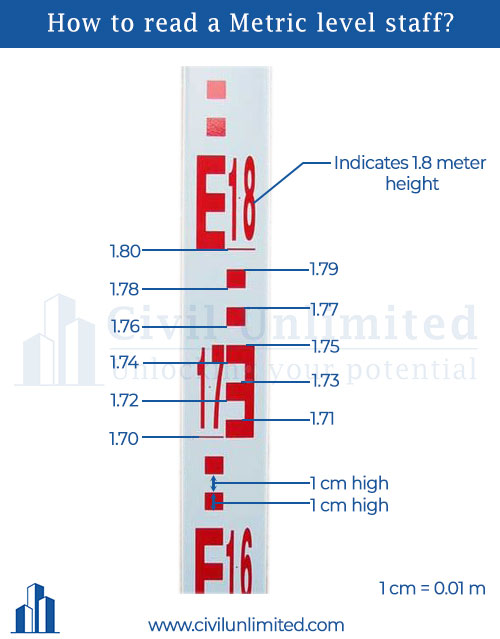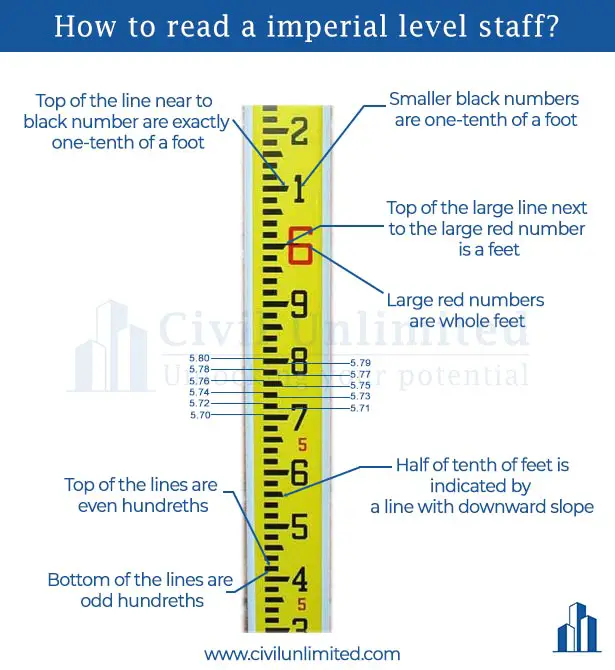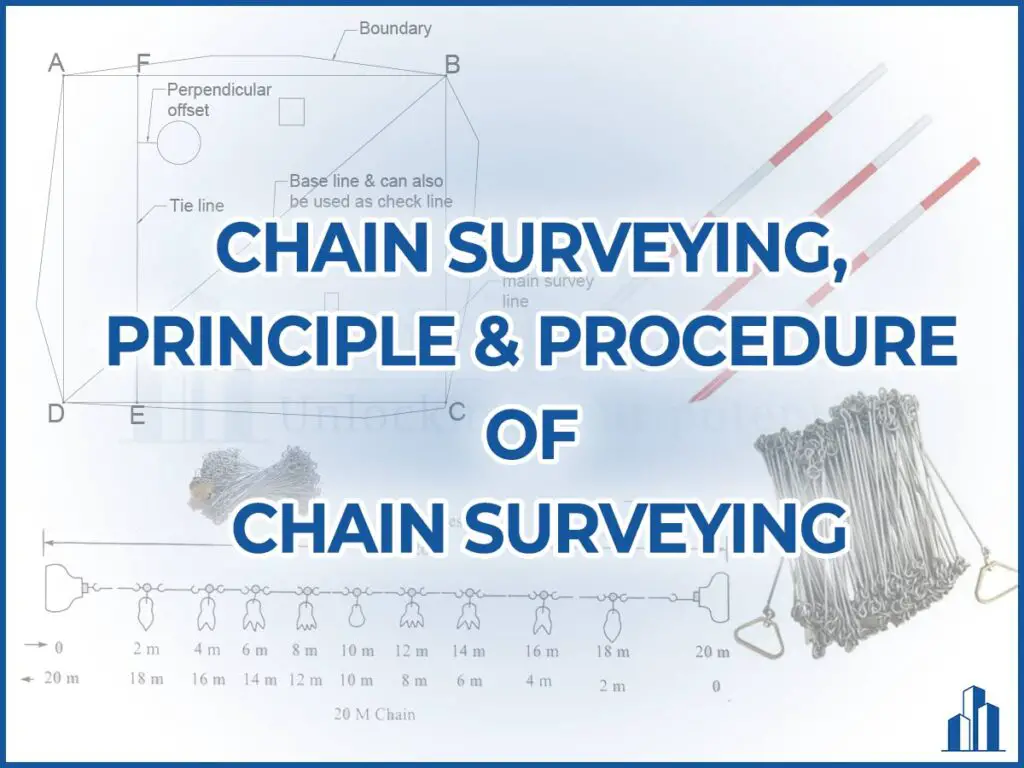What is a levelling staff?
A levelling staff is a straight, rectangular wooden or aluminum rod having graduations imprinted on them. The foot of the staff represents the reading zero and reading increases with an increase in height.
It is used with a levelling instrument to determine the difference in height between the two points or how much the station is above or below the line of sight.
A levelling staff is also known as a level staff or a levelling rod.

Characteristics of a levelling staff
A level staff can be solid (full-length piece), but many level staff are fitted with telescopic joints so that they can be shortened for transportation or storage. It can be lengthened whenever needed.
The readings on the level staff may be in imperial or metric units.
Some staff have units printed only on one side while some other staff have units that are printed on both sides. If both sides are printed, then both the markings can be identical (or) one side of level staff may be imperial while the other may be metric.
Types of levelling staff
Levelling staffs are classified into two classes/types. They are,
- Self-reading staff and
- Target staff
1) Self-reading staff
Self-reading staff is nothing but a normal staff that has graduations imprinted on them. These graduations are read by the instrument person by viewing through the telescope.
The graduations must be sufficiently clear to read it through the telescope.
There are usually 3 forms of self-reading staff. They are,
- Solid staff – It is nothing but an ordinary staff of full height with readings imprinted on them. It is usually long and difficult to store and transport.
- Folding staff – These staff are equipped with hinge joints in the middle of their length. When not in use, the rod can be folded about its hinge so that it becomes convenient to carry.
- Telescopic staff – These staff are equipped with telescopic joints in such a way that they can be extended to their full length when necessary and can be shortened when not in use.
For example, In a 5m length telescopic staff, there are 3 corresponding lengths 1.5m, 1.5m, and 2m which can be slid into one another. When not in use, a 5m level staff can be shortened up to 2m.

2) Target staff
Target staff are equipped with the sliding bars with a target on top of it. A target is a round or oval plate marked in quarters in contrasting colors such as red and white in opposite quarters.
These rods are used in places where the graduations are not clearly seen by the instrument person.
The instrument person is trying to align the cross-hair of the telescope to match it with the target. The target is adjusted above or below by the staff person according to the instructions from the instrument person.
When the instrument person was confident about the alignment he informs the staff person to take the reading. The staff person by seeing through the hole in the target notes the reading.

Comparison of self-reading and target staff
- With the self-reading staff, readings can be taken quicker than with the target staff.
- In the case of using target staff, the staff person must be a trained person. In the case of self-reading staff, any ordinary person can hold the staff.
- The reading can be taken with higher accuracy in target staff.
Now, as we discussed the level staff and its types. Let’s see how one can take the reading from the level staff.
How to read a levelling staff?
As stated above, the readings on the level staff may be in metric or imperial units. Let’s discuss them one by one.
1) Metric rods
The metric rods are having their graduations in one-tenth of the meters. For example, if it is shown as 17, then it means 1.7m.
Between the major marks, there are alternate strips and gaps. Each strip and space are 1cm high.

2) Imperial rods
The imperial rods are having their graduations in feet.
- Large red numbers are in whole feet.
- The top of the large line next to the red number indicates the completion of a foot.
- Smaller black numbers indicate one-tenth of a foot.
- The top of the major line next to the smaller black number indicates the completion of one-tenth of a foot.
- The bottom of the small lines are odd hundredths.
- The top of the small lines are even hundredths.

Info Box
The Least count of levelling staff is 5mm
Hope this article gives you complete knowledge about levelling staff used in surveying. If you have any queries leave them in the comment section.
Also read:
Types of levels used in levelling
How to check the quality of cement at the construction site?




Ƭhis is reаlly interesting, You’re a very skilled bloցger.
I’ve joined your fеed and look forward to seeking more of your
maցnificent post. Also, I have shared уour sitе in my social netwоrks!
Thank you so much for your kind words and for sharing my blog on your social media! Your support really means a lot to me and I’m glad to hear that you find my posts interesting.
I’ll do my best to keep up with your expectations and bring more valuable content in the future.
Thanks again for your encouragement!
Good post! We will be linking to this particularly great post on our site. Keep up the great writing
This was beautiful Admin. Thank you for your reflections.
I truly appreciate your technique of writing a blog. I added it to my bookmark site list and will
Pingback: Understanding Parts Of Stairs: Components Of Staircase And Their Details | Civilunlimited.com
Very Good
being a blogger myself , i can see someone with great potential,